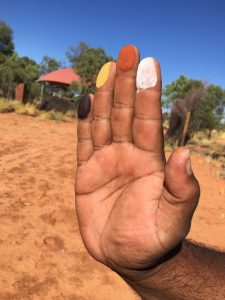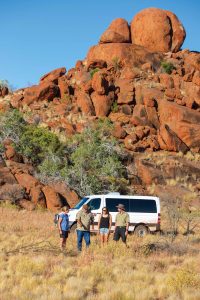If you are looking to make your next holiday one to remember, Australia’s Red Centre will not disappoint. With stunning desert landscapes and monolithic landmarks that change colour with the setting sun, you are sure to be amazed. But what many that visit us share is the part of their trip that left the most lasting impression was listening to the Aboriginal stories told by the Anangu traditional owners and depicted in the symbols of the Aboriginal rock art, about their culture and history on the land.
Uluru-Kata Tjuta National Park is a place known for its well-preserved rock art sites, with Anangu and park staff having documented and conserved approximately 80 sites within the park.
The Meaning of The Art
These Anangu rock art paintings have been created for the purpose of religious and ceremonial expression and for storytelling that has been passed down from generation to generation. When visiting the rock art sites at Uluru-Kata Tjuta National Park, you may notice that the paintings have been layered on top of each other. This is because Anangu educators and storytellers used these same sites for thousands of years.
The symbols and figures that make up these paintings often include geometric objects such as concentric circles, shapes that represent animal tracks, and the outlines of animals. These symbols are used by Anangu artists to represent different things, with the true meanings only made clear when the stories of the paintings are told. In some cases, the same symbol will be used for two different purposes. For example, concentric circles in some paintings represent a water hole and, in others, a place to camp.
A question we often get is ‘how old is the art?’. While it is hard to date the art found at Uluru accurately, as carbon dating only tells us the age of the rock and painting minerals, it is believed that people have occupied the Uluru region for over 30,000 years. These paintings are a historical record of their experiences.
Painting Materials
Unique in their design, the Anangu paintings are made from natural mineral substances mixed with water and sometimes animal fat. They are most commonly made up of red, orange, and yellow, which come from iron-stained clays called ochres, and white, black, and grey pigments, which are made from calcite, ash, and charcoal. While these colours do tend to weaken in the elements, they can still be observed in the park to this day.

Art Conservation
The Anangu traditional owners and park management have together established ways to conserve these art sites that have all been documented, with their cultural information, by specialist consultants.
Park rangers continue to maintain these sites by regularly removing nests and tunnels left behind by wildlife, and by issuing silicon drip lines around the paintings to minimise water flow, reducing the risk of mould diminishing the art.
When visiting the Red Centre, we ask that you also play your part in helping to conserve these sites. Along the Mala and Kuniya walks (which you will visit on our SEIT Uluru guided tour), there are viewing platforms alongside the rock shelters housing the art. Please remain behind these barriers at all times and inform your tour guide or a park ranger of any interference with the art you may witness.
How You Can See The Rock Art
There is an amazing amount of Aboriginal art and culture for you to take in on your visit to Central Australia, and our experienced tour guides are here to give you the chance to learn about their stories, the significance of their art and the history of the land.
For a true Aboriginal experience, join us on our SEIT PATJI tour. Accompany the Traditional Uluru Family to their homelands called Patji, containing what is considered to be one of Australia’s most sacred rock art sites, and spend time learning about the oldest living culture in the world and the role of rock art in their community.

After experiencing the park’s traditional rock art sites, a visit to the Uluru-Kata Tjuta Cultural Centre will give you the opportunity to view the more recent artwork of the Anangu people, with ceramics, paintings, and woodworks all on display.
Aboriginal Rock Art
At SEIT Tours, we want you to enjoy more than just the tourist side of Central Australia. Book your tour with us today!
